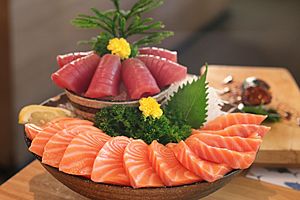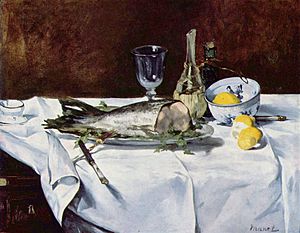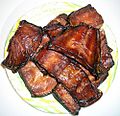Salmon as food facts for kids

Salmon is a very popular food fish. It's known as an oily fish because it has a lot of healthy fats. Salmon is packed with protein and special fats called omega-3 fatty acids, which are good for your body. Countries like Norway are big producers of salmon, both from farms and caught in the wild. Farmed and wild salmon are very similar in quality. Farmed salmon often has fewer pollutants, while wild salmon has more omega-3 fats.
Contents
What Color is Salmon?
| Nutritional value per 100 g (3.5 oz) | |
|---|---|
| Energy | 142 kcal (590 kJ) |
|
6.34 g
|
|
| Saturated | 1.0 g |
| Monounsaturated | 2.1 g |
| Polyunsaturated
omega‑6
|
2.5 g
2018 mg
172 mg
|
|
Protein
|
19.84 g
|
| Vitamins | Quantity
%DV†
|
| Vitamin A | 40 IU |
| Thiamine (B1) |
20%
0.226 mg |
| Riboflavin (B2) |
32%
0.380 mg |
| Niacin (B3) |
49%
7.860 mg |
| Pantothenic acid (B5) |
23%
1.164 mg |
| Vitamin B6 |
63%
0.818 mg |
| Folate (B9) |
6%
25 μg |
| Vitamin B12 |
133%
3.2 μg |
| Minerals | Quantity
%DV†
|
| Calcium |
1%
12 mg |
| Copper |
15%
0.3 mg |
| Iron |
6%
0.80 mg |
| Magnesium |
8%
29 mg |
| Phosphorus |
29%
200 mg |
| Potassium |
16%
490 mg |
| Selenium |
52%
36.5 μg |
| Sodium |
3%
44 mg |
| Zinc |
7%
0.64 mg |
| Other constituents | Quantity |
| Water | 68.50 g |
|
Link to USDA Database entry
|
|
| †Percentages estimated using US recommendations for adults. | |


Salmon meat is usually orange or red. But sometimes, you can find wild salmon with white meat. The natural color comes from special pigments called carotenoids. The main ones are astaxanthin and canthaxanthin. Wild salmon get these colors from eating tiny sea creatures like krill and other small shellfish.
Salmon Nutrition Facts
Raw wild salmon is mostly water (about 69%). It has a lot of protein (20%) and some fat (6%). It doesn't have any carbohydrates. A 100-gram serving of raw salmon gives you 142 calories. It's also a great source of many B vitamins, especially vitamin B12. You also get a lot of selenium and phosphorus. Salmon also has good amounts of copper and potassium.
What About Pollutants?
Scientists sometimes find small amounts of pollutants in wild salmon. These can include things like PCBs and mercury. These are often found in fish caught near big cities where wastewater is treated. However, farmed salmon often has lower levels of these environmental substances.
Protecting Wild Salmon
Some environmental groups work to protect wild salmon populations. They encourage people to choose salmon that has been caught in ways that don't harm the environment. This helps make sure there are enough salmon for the future.
Different Salmon Products
Most Atlantic salmon you see in stores is from farms. But most Pacific salmon is caught in the wild.
You can find salmon in many forms. Canned salmon in the U.S. usually comes from wild Pacific salmon. But you can also find farmed salmon in cans. Smoked salmon is another popular way to eat it. It can be hot-smoked or cold-smoked. Lox is a type of salmon that's cured in a salty water solution. Traditional canned salmon often includes some skin and bones, which are safe to eat and add calcium. You can also buy skinless and boneless canned salmon.
Raw salmon used to have tiny nematode worms called Anisakis. These worms can cause a sickness called anisakiasis. Because of this, people in Japan didn't eat raw salmon for a long time. But in the late 1980s, Norwegian salmon that was free of these parasites became available. This made it safe to use salmon and salmon roe (eggs) for sashimi (raw fish) and sushi. Cooked salmon is also very healthy. It contains good amounts of DHA and EPA. These are two types of healthy fatty acids.
Popular Salmon Dishes
| Name | Image | Origin | Description |
|---|---|---|---|
| Gravlax |  |
Nordic | Raw salmon cured with salt, sugar, and dill. It's often served as a starter, sliced thin with a dill and mustard sauce. |
| Lohikeitto |  |
Nordic | A creamy salmon soup with salmon pieces, boiled potatoes, and leeks. It's served hot with fresh dill. |
| Lomi salmon |  |
Polynesian | A side dish that's like a fresh salad. It's made by mixing raw salted salmon with tomatoes, sweet onions, and sometimes chili pepper. It's always served cold. |
| Lox |  |
European (Ashkenazi) Jewish | A fillet of salmon that has been cured. It's usually sliced very thin and served on a bagel with cream cheese, onion, and capers. |
| Rui-be | Japan | Salmon that is frozen outdoors, then sliced like sashimi. It's served with soy sauce and water peppers. | |
| Salmon burger |  |
A type of fishcake made mostly from salmon, shaped like a hamburger. It's a popular alternative to beef burgers, especially in Alaska. | |
| Salmon tartare |  |
A starter made with fresh raw salmon and seasonings. It's often spread on crackers or special bread. | |
| Smoked salmon |  |
Salmon fillet that has been cured and then hot or cold smoked. It's considered a special food because of its price. | |
| Salmon sashimi |  |
Japan | Sliced raw salmon served with decorations. People usually eat it by dipping it in soy sauce and wasabi. |
| Salmon sushi |  |
Norway | Sliced raw salmon rolled with rice and sometimes nori (seaweed) as makizushi. Or it can be placed on top of rice as nigiri sushi. It's served with garnishes and dipped in soy sauce and wasabi. |
| Kippered salmon | Hupa, Karuk, Yurok | Salmon smoked using fruitwood until it's cooked on the outside but still raw inside. Then it's canned and pressure cooked. |
Images for kids












